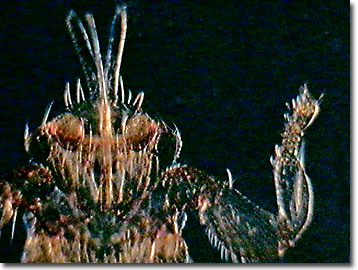Darkfield Digital Image Gallery
Sheep Ked Fly
The sheep ked, Melophagus ovinus, a wingless, bloodsucking fly is often misnamed the "sheep tick" because it resembles a large tick. However, as with the other members of the class Insecta, the sheep ked features only six legs and not the requisite eight of the ticks and fellow arachnids.

View a second image of a sheep ked fly.
View a third image of a sheep ked fly.
Although they occasionally bite humans and exhibit some success on goats, this flat, leathery, reddish-brown insect feeds almost exclusively on sheep. Well adapted for blood meals, the head is characterized by a noticeable piercing mouthpart that projects forward. Without a blood meal, the 4- to 7-millimeter keds perish within four days, but an engorged female can last up to eight days seeking a new host. In young lambs, these wingless flies can cause anemia and with adult sheep, retard weight gain. Keds and their pupae, when found in harvested wool, result in a "dirty wool" classification. Because of the sheep's negative immune response to the feeding keds, wool production also suffers.
Exhibiting complete metamorphosis, M. ovinus has a pupal stage that lasts for 3 to 6 weeks. The larval stage undergoes two molts while still within the mother. By the end of the growth period for the third instar stage, the female releases the larva on the host sheep (to pupate) and secures the future of the progeny by cementing them onto the wool. Eggs hatch one at a time instead in an episodic event. It takes about one or two months for the sheep ked to complete its life cycle. Because transmittal is due to sheep-to-sheep contact in flocks, isolation and shearing of infected livestock is prescribed, along with treatment by organophosphate insecticides or ivermectin. In the United States, sheep keds have virtually been eliminated through effective quarantine and treatments.
Contributing Authors
Cynthia D. Kelly, Thomas J. Fellers and Michael W. Davidson - National High Magnetic Field Laboratory, 1800 East Paul Dirac Dr., The Florida State University, Tallahassee, Florida, 32310.
BACK TO THE DARKFIELD IMAGE GALLERY
BACK TO THE DIGITAL IMAGE GALLERIES
Questions or comments? Send us an email.
© 1995-2025 by Michael W. Davidson and The Florida State University. All Rights Reserved. No images, graphics, software, scripts, or applets may be reproduced or used in any manner without permission from the copyright holders. Use of this website means you agree to all of the Legal Terms and Conditions set forth by the owners.
This website is maintained by our
Graphics & Web Programming Team
in collaboration with Optical Microscopy at the
National High Magnetic Field Laboratory.
Last Modification Friday, Nov 13, 2015 at 01:19 PM
Access Count Since September 17, 2002: 8616
Visit the website of our partner in introductory microscopy education:
|
|
